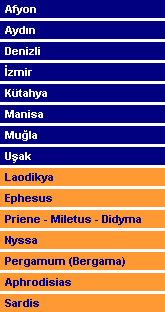| Ephesus... |
|
The findings obtained in this region where the native people, namely the Lelegs and the Carians have lived since the
beginning, indicate that the city is dated back to 2000 years BC. As far as the years of 1000 are concerned, it is assumed
that the Ions came to this region, lead by Androckles. Ephesos was captured by the Kimmers in 7th century BC,
by the Lydians in 560, and later in 546 BC by the Persians; and was rescued from the Persian domination when Alexander the
Great defeated the Persians. Lysimachos, a commander of Alexander's, had the settlement removed from the whereabouts of the
Temple of Artemis to the zone between the Mount of Panayir and the Mount of Bülbül, and had a wall built around the city.
The city was taken by the Kingdom of Pergamon after 190 BC, by Rome in 133 BC, and later by Byzantium, Ephesos maintained
its importance during the period of Christianity, and the apostle St. Paul arrived there during the years of 50 AD. It is
also a known fact that St. John was buried on the hill of Ayasuluk at the beginning of the 2nd century. Ephesos
lived through its third glorious period during the reign of Justinianus in the middle of the 6th century AD and, at this
time, the Church of St. John was built on the hill of Ayasuluk. The Temple of Artemis is also one of the places to visit
in Ephesos besides the Church of St. John. The Temple of Artemis, which had been built at first during the archaic period,
was one of the seven wonders of the world later during the Hellenistic period and, in the year 356 BC when Alexander the
Great was born, it was destroyed by a maniac and was reconstructed by the people of Ephesos. It has 127 columns and its
dimensions are 55 x 115 m. Some of the bases of the columns of temple are ornamented with raised relief design. The other
places to visit in Ephesos are the Cave of the Seven Sleepers, the house of the Virgin Mary, the Mosque of Isa Bey built
in 1375 and the Museum of Ephesos where the ancient remains found in the ruins of Ephesos are displayed. The ruins of
Ephesos, situated near Selçuk, are centers of interest owing to the ancient remains that are still existent. When you
enter through the Magnesia Gate from above you see the State Agora. The Temple of Isis is situated at the center of the
Agora, and Stoa is placed on the North side of it. The Odeion with a capacity of 1400 persons is placed behind it and the
Prytaneion where the sacred fire used to burn, is on its flank.
|
|

|











